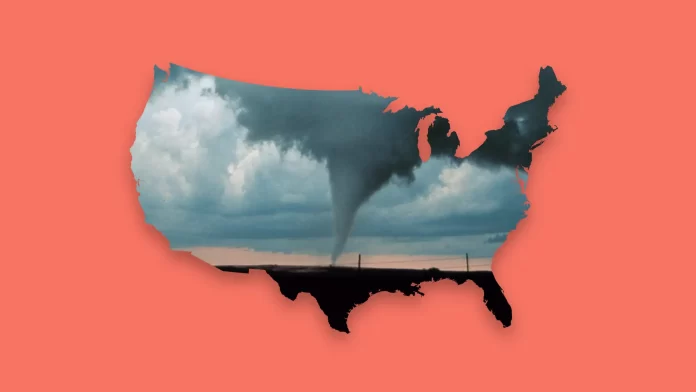Severe Weather Cripples Southern and Midwestern United States
A devastating storm system has raged through large portions of the U.S. South and Midwest, resulting in at least 16 weather-related fatalities by early Sunday. The severe weather began late Thursday, with tornadoes and flash flood warnings underscoring the threats that forecasters warned could lead to rising waterways in the days to follow.
Texas Tornado Season
In Texas, tornadoes are a notorious feature of the spring weather season, with May being the most active month. Historical data shows that from 1950 to 2024, an average of 42.3 tornadoes occur every May, underscoring the state’s vulnerability during this time. This year, the National Weather Service has advised that intense thunderstorms are expected to affect not only Texas but also the Great Lakes region and Appalachia.
Destructive Storm System Spans the Country
The storm system has brought heavy rainfall, high winds, hail, and flooding to millions across the U.S., from the South to portions of the upper Midwest. These spring weather patterns, characterized by fluctuating temperatures from lingering winter chills to sudden bursts of warmth, have created ideal conditions for deadly tornadoes. The mixing of cold Canadian air with warm, moist Gulf air is a recipe for disaster, as seen this weekend with a tornado outbreak affecting 13 states.
Flash Floods and Tornadoes: A Deadly Duo
States such as Mississippi, Tennessee, Kentucky, Arkansas, Missouri, and Indiana are grappling with relentless severe storms. These have led to flash flooding, numerous tornadoes, and extensive damage. Areas already saturated from previous storms faced new tornado and flash flood warnings, with Kentucky, Mississippi, and Tennessee particularly hard-hit.
Central U.S. Faces Severe Flooding
Catastrophic flash flooding, coupled with continuous rain, poses life-threatening risks to communities throughout the central U.S. This weekend’s torrential rains have swollen waterways from Texas to Ohio, prompting emergencies and resulting in 16 deaths, including tragic incidents like the one involving a 5-year-old in Little Rock, Arkansas.
Flooding’s Far-Reaching Implications
The impact of the extreme weather extends beyond immediate dangers to lives and properties. The Ohio River in Louisville rose five feet in just 24 hours, poised to continue rising, causing significant flooding. Flight disruptions were widespread, with over 521 flights canceled and 6,400 delayed. Interstate commerce is also threatened, particularly as major cargo hubs like Louisville and Memphis face delays due to the flooding.
Unrelenting Downpours in the Heartland
Since Wednesday, parts of Kentucky have received over a foot of rain, while Arkansas and Missouri have seen more than eight inches. Forecasters blame the severe weather on warm temperatures, an unstable atmosphere, strong wind shear, and moisture from the Gulf. Flash flood emergencies and tornado warnings persist across Arkansas, Mississippi, Tennessee, and Kentucky. The state of Kentucky struggles with impassable roads due to floodwaters, downed trees, and landslides.
Communities in Crisis
In Dyersburg, Tennessee, locals sought refuge in storm shelters, clutching essentials as they prepared for the continuing onslaught of rain and severe weather. As the region braces for more rainfall and potential river flooding, the resilience of communities will be tested.
As the storm system continues its path of destruction, the nation watches with bated breath, hoping for relief and recovery in the days to come.








